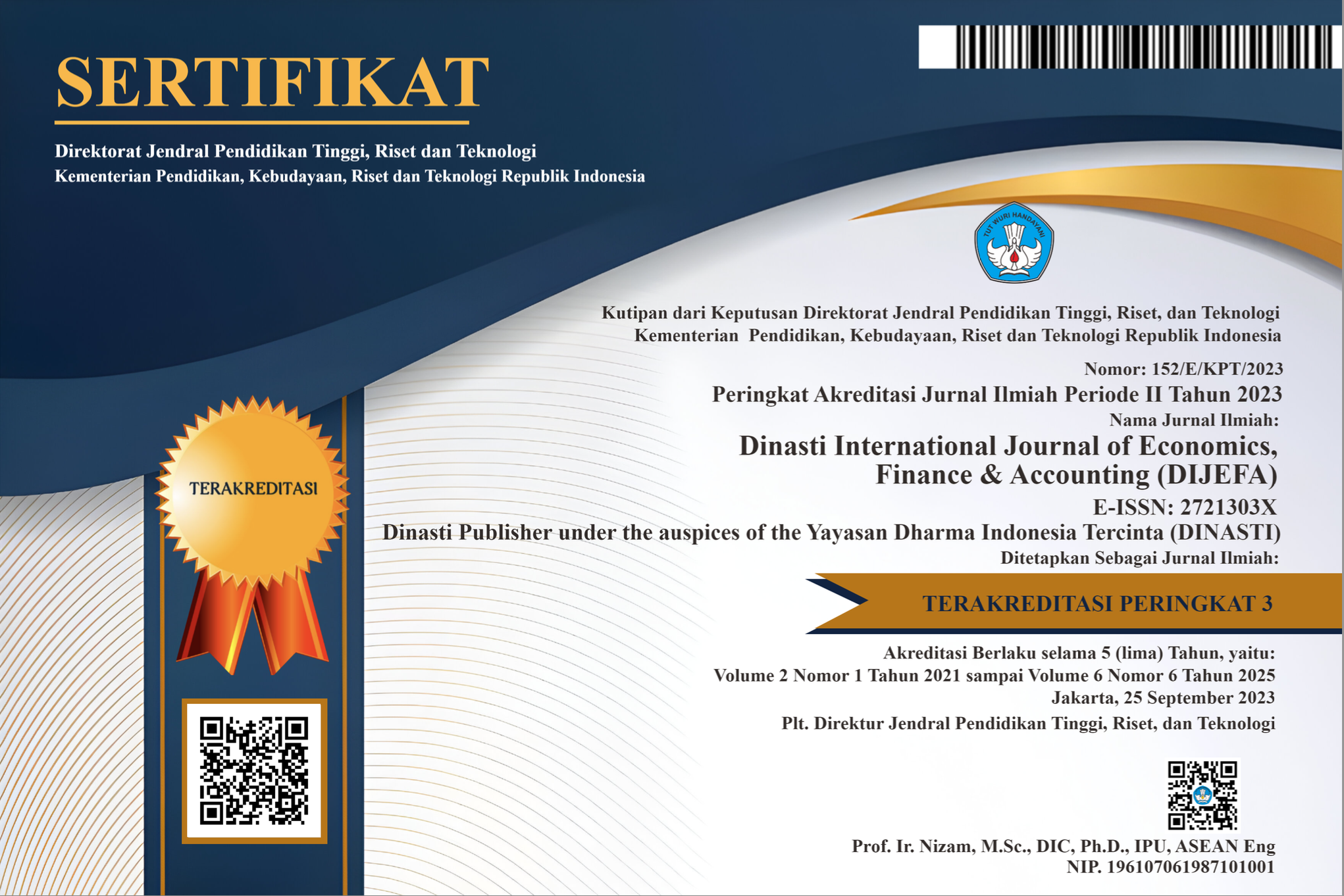The Effects Of Transformational Leadership, Power Distance, Communication, and Followership On Employee Decision Making
DOI:
https://doi.org/10.38035/dijefa.v5i3.3130Keywords:
Effects Of Transformational Leadership, Power Distance, Communication, Followership, Employee Decision MakingAbstract
This study aims to determine the effect of transformational leadership, power distance, communication and followership on employee decision making. The type of research used in this study is research with a quantitative approach. Population in this study using the population census where employees at the Office of manpower, investment, and Integrated Services One Door Banjarnegara as many as 59 people. This study used primary data obtained by distributing questionnaires. To produce alternative answers this study uses a Likert scale. This study used slovin formula for sampling. The results of this study showed that transformational leadership, power distance does not affect employee decision making, while communication and followership affect employee decision making.
References
Amin, Hamidah, & Gunawan. (2020). The influence of transformational leadership, power distance, and followership on the decision making capability. Management Science Letters, 10((16)), 3915–3922.
Azis, A. (2022). Pengaruh Kepemimpinan Dan Komunikasi Terhadap Pengambilan Keputusan Dan Dampaknya Pada Kinerja Karyawan Rumah Sakit Amc Kabupaten Bandung. Doctoral Dissertation, Perpustakaan Pascasarjana.
Azkiyah, Zamarotul, Oenaimnou, J., Silaban, W. G., Trianung, T., & Supadi. (2023). “Study Literature Review: Peran Kepemimpinan Transformasional Dalam Pengambilan Keputusan Untuk Menghadapi Tantangan Abad 21”. Jurnal Kepemimpinan Dan Pengurusan Sekolah, 8(2). https://ejurnal.stkip-pessel.ac.id/index.php/kp/article/view/121.
Fatimah. (2020). Peran Pemimpin Dalam Meningkatkan Kinerja Karyawan Di Percetakan Dan Sablon Gapura Jaya Ponorogo. IAIN PONOROGO.
Fauzi, M. L., Survival, & Mulyono. (2023). Efek Kepemimpinan Transformasional, Power Distance dan Followership terhadap Kemampuan Pengambilan Keputusan Karyawan. Jurnal Ekonomi, Akuntansi Dan Manajemen, 2(4), 172–187.
Fitriani, L. (2007). Kepemimpinan dan pelayanan dalam organisasi publik. Jurnal Ilmu Administras, 4(4), 05–05.
George Terry. (1960). The Principles Of Management (Illnois). Irwin, Inc.
Greenwald, H. (2013). Organizations: Management without Control. SAGE.
Hasibuan, M. S. . (2008). Manajemen Sumber Daya Maanusia. Jakarta: Bumi Aksara. http://books.google.com/books?id=ZQk0tAEACAAJ&dq=inauthor:hasibuan&hl=&source=gbs_api%0Ahttp://repository.pelitabangsa.ac.id/xmlui/handle/123456789/1720
Jensen, M. C., & Meckling, W. H. (1976). Theory of the firm: Managerial Behavior, Agency Costs and Ownership Structure. Human Relations, 72(10), 56. https://doi.org/10.1177/0018726718812602
Khatri. (2009). Consequences of power distance orientation in organisations. Vision.
Macmillan, K. (2013). Leaders, Followers, and the Space Between: A Three Dimensional View of Leader Attention and Decision-making. Electronic Thesis and Dissertation Repository.
Mary, C., Teresa, & Lawrehce. (2012). A Cross-Cultural Study of the Influence of Country of Origin, Justice, Power Distance, and Gender on Ethical Decisioin Making. Journal Of International Accounting Research, 11(1), 5–34.
Northouse. (2013). “Leadership: Theory and Practicfe.” Sage Publication Inc.
Purba, B., Hasoloan, A., & Yasir, A. (2021). Komunikasi Organisasi dalam Proses Pengambilan Keputusan di UPT-PTPH Provinsi Sumatera Utara.". JURNAL SIMBOLIKA Research and Learning in Communication Study, 7(1), 84–95.
Riaz, A. M. H., Iqbal, A., & April. (2010). Role of transformational and transactional leadership on job satisfaction and career satisfaction. Journal Business and Economic Horizons, 1(1).
Rivai, & Mulyasi. (2010). Kepemimpinan dan Perilaku Organisasi. Rajawali Press.
Roan, Pearce, & Xin. (2016). Should management practice adapt to cultural values? The evidence against power distance adaption. Cross Cultural & Strategic Management, 23(2).
Robbins, S., & Timoty. (2008). Perilaku Organisasi. Salemba Empat.
Scott, D. F., & Lesch, W. (1997). Streamflow responses to afforestation with EucaZypfus grundis and Pinus putuZu and to felling in the Mokobulaan experimental catchments , South Africa. 199, 360–377.
Suri, B. (2019). “Impact of Communication Styles and Social Influence on Major Decisions and Emotional Well-being: A Review Article.” Texila International Journal of Academic Research.
Watt, G. (2008). Aromaterapi in Nursing and Mental Health Care. Journal of Contemporary Nurse, 30(1), 69–75.
Downloads
Published
How to Cite
Issue
Section
License
Copyright (c) 2024 Maulidya Dita Maharani, Fatchan Achyani

This work is licensed under a Creative Commons Attribution 4.0 International License.
Authors who publish their manuscripts in this journal agree to the following conditions:
- The copyright on each article belongs to the author(s).
- The author acknowledges that the Dinasti International Journal of Economics, Finance & Accounting (DIJEFA) has the right to be the first to publish with a Creative Commons Attribution 4.0 International license (Attribution 4.0 International (CC BY 4.0).
- Authors can submit articles separately, arrange for the non-exclusive distribution of manuscripts that have been published in this journal into other versions (e.g., sent to the author's institutional repository, publication into books, etc.), by acknowledging that the manuscript has been published for the first time in the Dinasti International Journal of Economics, Finance & Accounting (DIJEFA).


























































